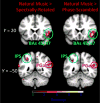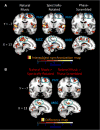Inter-subject synchronization of brain responses during natural music listening
- PMID: 23578016
- PMCID: PMC4487043
- DOI: 10.1111/ejn.12173
Inter-subject synchronization of brain responses during natural music listening
Abstract
Music is a cultural universal and a rich part of the human experience. However, little is known about common brain systems that support the processing and integration of extended, naturalistic 'real-world' music stimuli. We examined this question by presenting extended excerpts of symphonic music, and two pseudomusical stimuli in which the temporal and spectral structure of the Natural Music condition were disrupted, to non-musician participants undergoing functional brain imaging and analysing synchronized spatiotemporal activity patterns between listeners. We found that music synchronizes brain responses across listeners in bilateral auditory midbrain and thalamus, primary auditory and auditory association cortex, right-lateralized structures in frontal and parietal cortex, and motor planning regions of the brain. These effects were greater for natural music compared to the pseudo-musical control conditions. Remarkably, inter-subject synchronization in the inferior colliculus and medial geniculate nucleus was also greater for the natural music condition, indicating that synchronization at these early stages of auditory processing is not simply driven by spectro-temporal features of the stimulus. Increased synchronization during music listening was also evident in a right-hemisphere fronto-parietal attention network and bilateral cortical regions involved in motor planning. While these brain structures have previously been implicated in various aspects of musical processing, our results are the first to show that these regions track structural elements of a musical stimulus over extended time periods lasting minutes. Our results show that a hierarchical distributed network is synchronized between individuals during the processing of extended musical sequences, and provide new insight into the temporal integration of complex and biologically salient auditory sequences.
© 2013 Federation of European Neuroscience Societies and John Wiley & Sons Ltd.
Figures








References
Publication types
MeSH terms
Grants and funding
LinkOut - more resources
Full Text Sources
Other Literature Sources

